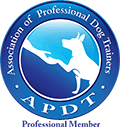Archived OLDT :: Getting Your Dog Cafe-Ready
I share my life with a German Shepherd Dog named Trista. From the very start of our life together, I trained her to hold a good down-stay. For those first weeks and months, we actively practiced everywhere: at home, on park benches, in sidewalk cafes. The first stages required frequent food reinforcement, or reward, to keep her attentive and working. As she became more consistent, I spaced out the food rewards, relying more on verbal encouragement. And with more time, she accomplished fairly long stretches with no attention from me at all.
Developing this behavior in your dog just takes careful, thorough practice with gradual progression. Here's a step-by-step tutorial that will help you get your dog cafe-ready:
Cueing the Down
It's usually easiest to begin by starting with your dog in a sit. Lure the down by holding a treat in your down-turned palm below his nose and move it down between his paws. Your pup may need you to pull the treat forward a bit or back towards his chest to elicit the down. When he's doing this with fluency, fake the lure in the hand, signaling with the same down-turned palm, and treat from the other hand. This translates the cue from a lure to a hand signal.
When you'd bet your life that when you make that gesture, he'll go down, start putting the word "down" before the hand signal. The word becomes predictive that the down hand signal will follow and so will eventually elicit the behavior with only the word. Ultimately you want to be able to give the hand signal from any position, so practice cuing from a standing position, while seated in a chair, etc.
To advance, gradually lift your hand signal up from the floor by inches incrementally, remembering that the hand signal will look a little different in each context. Teach your pup that the cue means the same thing from every altitude.
Additional note: If your dog is having trouble being lured into the down, build habit by watching for times when he typically lies down, perhaps in the evening while you're settling down in front of the TV and, at the very moment he lies down, mark it with a happy "yes!" and give treats one after the other. In no time he will start to notice that the down position is a very rewarding one!
Teaching your Dog To Hold the Down (an Implied Down-Stay)
Some dogs tend to pop up out of the down once they've collected their treat. The way to work on this is to give little morsels, one after the other, in quick succession as long as your dog remains in the down. If your dog gets up, mark with an "uh-uh" and the treats stop. Ask for a down again and start treat after treat again. Little by little, increase the time between treats, using soft verbal encouragement to bridge the gap between treats. Periodically allow your dog to break the down with the release word "OK!" and encourage him to get up, but don't give him a food treat. This way he's learning that being in the down is rewarding, getting up is not. Gradually work on you being able to stand between treats without your dog getting up. Also do the exercise while you're in a seated position.
A Tip: When working on sedentary exercises like these, it's best if your dog has already had a bit of exercise and is ready for some quiet time. When he's fresh first thing in the morning, he's going to be raring to go and in no mood for holding a down-stay.
Next Steps: Proofing
Now that your dog is holding the down fairly solidly, you need to build his ability to do it under many different circumstances. Remember that, with each jump in difficulty, you need to reward your dog more frequently.
Duration: Remember to build on duration gradually... don't expect him to hold the down for a half an hour right from the start. Start with 5 or 10 seconds, gradually increasing it. If you notice that he's frequently breaking from the down before you've released him, you may be expecting too much of him; cut back on duration. Set him up for success.
Distance: Start incorporating some movement into the exercise. These are really exercises in proofing a stay without the use of the word: With your dog in a down, back away a step, then come back to treat. Turn a quarter turn, then a half turn so that he sees your backside, then turn back and come back to treat. Step to the side; do a little hop; walk part way around him -- but build gradually. Again, set him up for success!
Distraction: At this point, you should be able to stand or sit with your dog beside you, giving occasional treats and bridging with some verbal encouragement. Change venues: practice in different rooms of the house, or in the hallway of your apartment building.
A Tip: With each jump in difficulty, you need to reward your dog more frequently.
Taking It On the Road
With your dog's meal in your pocket, take a walk together. Periodically find a place to stop, ask your dog for a down, and start feeding him his kibble. After a short time, say "OK, let's go!" and resume your walk. For a hungry dog, the stops along the way will be a very welcome snack. Sit on a park bench, a neighbor's stoop, anywhere you can find a spot. Start with quieter byways and build gradually to streets more active with people, dogs, and traffic.
A Tip: Remember that the outside world is way more distracting than your nice quiet home, so reward very frequently. If necessary, mix something really yummy in with his kibble, or use something altogether better.
Travels with Trista
These days I take Trista everywhere, on trips across the country involving boat ferries, horse-drawn carriages, motels and shops that allow dogs and, of course, sidewalk cafes. She can go so many places with me precisely because she is a pleasure to be with and around: she lies quietly beside me, bothers no one by soliciting attention or making noise, tolerates the unexpected with grace, and seems happy just to be included. And our relationship is deepened precisely because of the mutual respect we have for each other and because we can share so much together.
With patient, thorough work, this is the life you can share with your dog, too. He is a cafe companion in the ruff!




